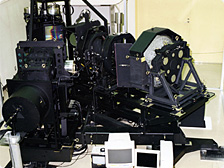
Kazumi Obata
Production Department,Nikon Customized Products Division
Joined Nikon in 1980. Became a specialist in device assembly and adjustment after working as a small-parts metal-working engineer. Appointed as Nikon Master Craftsperson in 2007.
To the question "What is the finishing technique?" Kazumi Obata replies, "Finishing is to complete a product by adjusting it by hand using various sorts of tools to a level of precision beyond that of machines."
The products that Mr. Obata has had a hand in have all been high-tech, high-performance instruments, including large astronomical telescopes like "Subaru" on the summit of Mauna Kea in Hawaii and IC steppers and scanners. This work is not a simple matter of assembling parts. While assembling high-precision parts, various adjustments must be made for each part to achieve the necessary precision.
With improvements in the quality of machining, the precision of metal parts has risen in recent years. However, it is difficult to completely remove the slight imperfections that occur when processing parts. Correcting for these minor imperfections so as to bring the part to within an acceptable tolerance is one of the skills required in finishing.
Finishing is vital to the completion of high-precision products, and involves adjusting the surfaces and angles of joining parts as well as making various different adjustments to achieve the necessary precision.

The large optical-infrared telescope "Subaru," located at the peak of Mauna Kea on the Island of Hawaii. Mr. Obata was in charge of assembling and adjusting the Faint Object Camera and Spectrograph (FOCAS) and High Dispersion Spectrograph (HDS) units used on the Subaru telescope.

FOCAS: Observing light from the far side of the Milky Way (Photograph: National Astronomical Observatory)

HDS: Observing light from celestial objects within the Milky Way (Photograph: National Astronomical Observatory)

